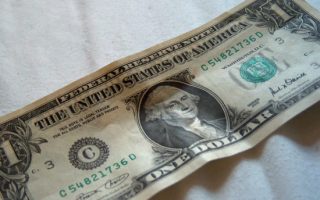 As of June 2018, Americans owed an astounding $1.039 trillion in revolving debt. Additionally, the average American owes about $6,400 in credit card debt alone.
As of June 2018, Americans owed an astounding $1.039 trillion in revolving debt. Additionally, the average American owes about $6,400 in credit card debt alone.
Rising debt loads can be hard to combat. Often, it takes a significant amount of time to pay down these financial obligations. However, you can speed up the process with dedication and diligence.
In some cases, an all-cash diet can make eliminating debt easier. At a minimum, it prevents you from adding to your total, allowing you to chip away at your debt more effectively. You can also amp up the process by setting a strict spending limit.
If you think an all-cash diet is a challenge you can handle, here’s what you need to know.
What is an All-Cash Diet?
An all-cash diet involves using only physical currency to handle your daily expenses. For example, you would only use cash to pay for gasoline for your car, groceries, and similar expenditures.
Fixed expenses, like debt payments, housing costs, and utility bills, don’t have to be paid in cash. Instead, you can handle those electronically, such as through direct debits or with a debit card. However, you want to avoid using credit to pay these costs. Otherwise, you might not be able to lower your total debt load, which is often the primary goal of using an all-cash diet.
How Do You Start an All-Cash Diet?
The first step you need to take is to create a budget. Outline all of your fixed expenses and determine how much income you have left over. Your remaining money is the maximum you can spend on fluctuating day-to-day costs, such as food and fuel.
Next, you withdraw your remaining income as cash. Ideally, you want to divide the money up into spending categories, ensuring you allot enough to each area to cover your needs. You can designate an envelope to hold the funds for an individual category, making it easier to track.
For instance, you may have an envelope for groceries and another one for gasoline. As you divide the money, make sure you are realistic about what you need to spend to maintain a reasonable lifestyle.
Alternatively, you can divide the cash according to the number of weeks you have between paychecks. For example, if you get paid biweekly, then you would have two envelopes and would likely split your money in half, making each one equal in value.
Regardless of the approach you use, there is one additional step worth taking. Certain expenses, like oil changes, come up regularly, but not always on a set schedule. That can make covering these with your weekly or monthly allotments feel challenging.
Instead of using money out of your main spending envelopes, consider creating another one to set aside for these costs. Then, take a small amount out of each paycheck and set it aside in that envelope. How much you need in this category depends on your unique needs.
However, by considering all of the costs you encounter throughout the year, you can come up with an approximate annual total. Then, divide that amount by the number of weeks in a year or the number of paychecks you receive. Now you’ll know what you need to set aside.
Using the All-Cash Diet
Once you have your money in hand, use cash to cover every purchase you make. By doing so, you are functioning on an all-cash diet.
While the premise is simple, that doesn’t mean things can’t get tricky. For example, if you run out of cash for the week, in a category, or before your next paycheck, then you can’t buy anything else until it is time to replenish that envelope. Instead, you may have to get creative about managing your needs, ensuring you don’t rely on credit to cover the shortfall.
Ideally, since running out of money is a possibility, it will make you more aware of your spending decisions. Paying with cash makes shopping seem more tangible, as you can watch your money leave your hands and see that you have less available to make it until the envelope is refilled.
If you want additional value out of the process, whenever you spend money, but the receipt back in the envelope. This will let you review your spending at the end of the week or month, helping you to spot issues that may be hurting you financially.
Often, people using an all-cash diet are less likely to make impulse purchases. This can be incredibly beneficial for individuals who tend to overspend when using plastic.
What About Left Over Money?
In some cases, you’ll discover that there is still money in the envelope when it is time to replenish your funds. When this happens, you have a few choices.
If you don’t have an emergency fund, you can save the extra cash in a savings account. This helps you create a financial buffer against unexpected events, like a large medical bill or car repair.
For those who already have an emergency fund, then the spare money can help you pay down your debt. Send the excess to your highest interest debt as an extra payment, allowing you to lower your total and reduce interest charges.
You can also use the remaining money for irregular expenses, like birthday gifts. If that is your goal, open a savings account to store these funds. Then, when it’s time to make those purchases, pull out the money you need.
How Long Do I Need to Be on an All-Cash Diet?
How long you stay on an all-cash diet is up to you. Usually, you need to consider your goals and choose a duration that helps you achieve them.
However, if you aren’t sure whether an all-cash diet is right for you, consider starting off with one month. This will give you a realistic picture of what living on cash is like, allowing you to assess the process thoroughly.
At the end of the month, review how you did. If you were able to complete the time with little hardship, then remaining on an all-cash diet may work for you.
If you ran out of money or had other difficulties, then review your budget again and go over your shopping receipts. Did you properly allocate your cash? Did you make any unnecessary or impulse purchases? Is a lifestyle adjustment necessary to be successful?
By taking a hard look at your habits, you may find areas where you could save, making sticking with an all-cash diet easier to manage. However, it isn’t uncommon to have to make sacrifices, especially if you were using credit to support a lifestyle you can’t actually afford.
After reassessing, consider staying on the all-cash diet for another month. Then, take a look at how you did this time to see if you made progress.
Even if you don’t choose to stay on an all-cash diet, it’s still a valuable experience. You’ll have a better understanding of your spending habits and should have a more functional budget, making it easier to keep your finances under control.
Have you tried an all-cash diet? Tell us about your experience in the comments below.
Looking for more great money challenges? Here are some articles worth exploring.
If you enjoy reading our blog posts and would like to try your hand at blogging, we have good news for you; you can do exactly that on Saving Advice. Just click here to get started.
Tamila McDonald is a U.S. Army veteran with 20 years of service, including five years as a military financial advisor. After retiring from the Army, she spent eight years as an AFCPE-certified personal financial advisor for wounded warriors and their families. Now she writes about personal finance and benefits programs for numerous financial websites.






Comments